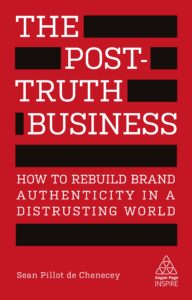Trust.
It seems the days are gone when we trust easily. From individuals to organizations, our trust seems to be declining with each passing year.
And yet organizations build their brands on trust.
In his newly released book, The Post-Truth Business: How to Rebuild Brand Authenticity in a Distrusting World, researcher and strategist Sean Pillot de Chenecey shares what brands need to do to have authentic, long-lasting relationships with their consumers in an age of fake news, privacy issues, and the search for truth.
The Number One Issue Facing Brands
Your view on the importance of trust is clear from the very first page where you say, “Trust is the number one issue facing brands on a global basis.” What leads you to this conclusion? How is this different than years ago?
Around the world, brand foundations are being shaken. It’s apparent that many brand-consumer relationships are on rocky ground, and something fundamental needs to change.
According to The Economist, “Consumer trust is the basis of all brand values, and therefore brands have an immense incentive to retain it.” And as that immensely powerful business-figurehead Jack Ma, CEO of Alibaba, stated so succinctly, “Once you have trust, the rest is easy.” However, these statements are set against a harsh reality illuminated by a much-cited industry report from the Havas agency, which noted that, “Much of the trust, respect and loyalty people had for many brands has disintegrated. You see it in the level of cynicism, skepticism and indifference that people have towards them.”
Company strategists are finally realizing that consumers are increasingly judging brands by how they actually behave, as opposed to simply believing the stories they tell. Thus, their brand credibility needs to be based on fact, not fiction. Businesses want to have strong and long-lasting relationships with their consumers. That brand-consumer relationship is built on trust, but in a post-truth world, brands are faced with a serious challenge: so much of modern life is defined by mistrust. So, for brands today, trust and truth are the most important games in town.
How to Build Trust
Share a few of the principles organizations should use to build trust.
To act as a reference guide for the leaders of ‘good businesses,’ I’ve collated the key learnings into a ‘Post-Truth Brand Manifesto.’ Here is a very brief summary of it…
Be authentic.
Truly authentic companies that want to earn and keep our trust have to ‘live it like they say it’ and dovetail brand intentions with the consumer reality. Because from a customer point of view, behavior is what builds brand credibility and corporate integrity, not merely the advertising stories that a brand may choose to tell.
Be transparent.
or brands to thrive, business leaders need to find a way to regain and retain the confidence of employees. This starts with transparency. This is a business-wide issue, involving every facet of the organization.
Respect privacy – It’s hard to overstate the seriousness of this subject—and the levels of antipathy engendered towards businesses that are seen to be profiting from ‘surveillance capitalism.’
Demonstrate empathy – More and more people want to find ‘meaning and purpose’ in their working lives and are attracted to culturally aware, ‘good neighbor’ companies that reflect their viewpoints as ‘social citizens.’
Be trustworthy.
Its no coincidence that companies which are trusted most tend to be legacy brands which have clearly demonstrated their ‘good business’ and/or ‘reliable product’ credentials, or indeed are those with transparency built-in to the core of their business model.
Do businesses that develop a reputation for trust have shared characteristics?
Yes. But a vital point to note is that just running an advertising campaign stating that a brand is trustworthy isn’t good enough. This isn’t a marketing issue, this is a business-wide issue, involving every facet of the organization, hence leadership being so important.
Companies have to be consistent in their behavior, from top to bottom, and right along the supply chain, from the ‘first hand of production to the final hand of the consumer.’ But a problem that’s becoming ever more visible is that some organizations have made authenticity their marketing strategy, rather than a business one. As a result, they come across as manufactured i.e. the very opposite of authentic.
And this genuinely has to go all the way. Make no mistake, organizations and brands that want to earn and keep our trust have to ‘live it like they say it.’ Because business has to be about more than just profit, ‘People plus Planet’ and—to quote a much-derided word—‘Purpose’ have to be in there, too.
The actual difference between ethical brands with a moral code and those exposed as being without one is increasingly a key factor in consumer brand adoption or rejection. This approach very much links to social innovation and, indeed, conspicuous altruism.
What are they?
‘Social Purpose’ is a phrase used obsessively by modern, forward-thinking leaders, and it links directly to joint value creation where both shareholders and society benefit from business. Yet many still attempt to portray, or indeed dismiss, the demographic most associated with this ideal as being one where, as The Guardian newspaper put it recently, “The idea that market activity should have a purpose other than purely profit is roughly where it always was on the spectrum, somewhere between Marx and Jesus – one for the rioters, the subversives, the people with beards, unsuited to mainstream discourse.
To illustrate that this thinking goes right to the top of hard-headed business thinking, in their ‘Reflections from Davos’ report regarding the 2018 meeting of the World Economic Forum, the managing partner of McKinsey was quoted as saying, “The next innovation imperative will be social innovation – business’s role will be critical here.” The report went on to note, “Society is demanding that companies, both public and private, serve a social purpose.”
How to Develop a Culture of Trust
How do leaders best develop a culture of trust?
Good question! This is set against research from those such as Deloitte who show how millennials are fast losing faith in business and against a backdrop where people are scrambling to find solid ground in an era when we’re told that the very notion of truth is subjective, and indeed much of public discourse has become increasingly anti-fact and anti-expert.
Fortunately, there are numerous shining examples of organizations that are showing us ‘how to do it better’ ranging across the business spectrum, in sectors from beauty to finance, and from fashion to beverages. With good leadership at the core of these businesses, every member of the organization is enabled to understand and demonstrate ‘why they do it, what they do, and how they do it.’ And this means leaders of companies are taking deliberate and definitive action to ensure that their businesses demonstrate ‘corporate social leadership.’ Along with making reputable products, providing employment and returning dividends to shareholders, corporations can and should endeavor to make the world a better place, contributing to and engaging with society.
This will also enable the truism that ‘good business is good business.’
The end result, from a customer point of view, is that these brands are then seen by the consumer as being on their side, standing with them and matching their own values in an inspirational manner. Because in a post-truth era, we want, and need, to believe in something. And increasingly, brands that really do ‘live it like they say it’ are some of the few things on which we can actually believe and rely.
Would you share an example of where trust was damaged but then rebuilt?
A classic example of a brand ‘losing it and then finding it’ is Nike. Look no further than the recent Kaepernick ad – the type of ongoing apolitical campaigning of which I believe we’ll see more and more – for an illustration of this.
How do corporate communications need to shift in today’s age of misinformation?
The death of advertising has been long foretold, but there’s no doubting that the communications world in general, and the advertising one in particular, are in turmoil.
A lack of trust also points an accusing finger at the advertising industry. In the annual Ipsos MORI Veracity Index, nurses and doctors are at the top of the ‘public trust in professions’ list, while trust in journalists is also at a record high. In fact, they gained their highest score since the survey began (Ipsos MORI, 2017). Trust in the advertising industry is generally held to be so low that it doesn’t even make the report. A basic but staggeringly important point was taken up by McKinsey, who states that, “Marketers may spend millions on advertising, yet often what really makes up a consumer’s mind is not only simple but free: a word-of-mouth recommendation from a trusted source. As consumers overwhelmed by choices tune out the barrage of traditional marketing, word-of-mouth cuts through the noise quickly and effectively.”
For more context about the overall problem, let’s not forget that we exist in a time of so-called #Infosmog due to the sheer amount of advertising, social media, general background information, real & fake news, and entertainment; all of which are vying for people’s attention 24/7. Add to this the staggering amount of ongoing disruption throughout these areas (and more), and the manner in which we consume media and entertainment of every conceivable type means that we’re living in what marketers love to call the ‘Attention Economy’ where the battle to win our attention generally involves every person, brand and company involved is essentially trying to shout louder than everyone else. The result is chaos. Hence the rise of adblockers and every conceivable method that most of us can think of to avoid being interrupted and intruded upon by these unwelcome outsiders.
To state the staggeringly obvious, brands matter hugely. But primarily, it’s the ones that we trust and have an emotional relationship with—the ones who tell their stories via powerful stories that will gain and retain our loyalty. It sounds so self-evident, so obvious as to be almost not worth saying. Until you consider the omnipresent deluge of brand communication that consistently fails to be ‘motivating, engaging and relevant.’ (That’s even if we notice it in the first place.) The amount of time, money and effort that the marketing world wastes almost defies belief, and it’s a common complaint from advertisers.
 This is why I think dynamic ways forward are being shown by a combination of approaches: from agencies creating major brand communication built on trust or via catalytic activity that generates fame, as explained by John Dunleavy at McCann’s; to those like Strawberry Frog assisting brands to build ‘cultural movements.’ Whereas others like Chapter SF help to create ‘brands with soul’ that prove their value in our lives.
This is why I think dynamic ways forward are being shown by a combination of approaches: from agencies creating major brand communication built on trust or via catalytic activity that generates fame, as explained by John Dunleavy at McCann’s; to those like Strawberry Frog assisting brands to build ‘cultural movements.’ Whereas others like Chapter SF help to create ‘brands with soul’ that prove their value in our lives.
These examples give us ‘headlight vision’ to shine a path in the incredibly disruptive and challenging world of brand communications. But what they each have in common is a commitment to creating activity with meaning. And that meaning has to link with the authenticity of the brand.
Because make no mistake, Ad Land finds itself thrust into the spotlight, cast as a Post-Truth Business, where rebuilding brand authenticity is absolutely vital in a distrusting world.

